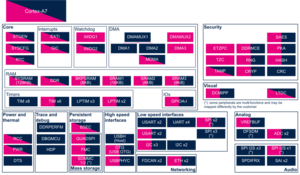1. Article purpose[edit source]
The purpose of this article is to:
- briefly introduce the RNG peripheral and its main features
- indicate the level of security supported by this hardware block
- explain how each instance can be allocated to the runtime contexts and linked to the corresponding software components
- explain how to configure the RNG peripheral.
2. Peripheral overview[edit source]
The RNG peripheral is used to provide 32-bit random numbers.
2.1. Features[edit source]
Refer to STM32MP13 reference manuals for the complete list of features, and to the software components, introduced below, to know which features are really implemented.
2.2. Security support[edit source]
RNG is a secure peripheral (under ETZPC control).
3. Peripheral usage and associated software[edit source]
3.1. Boot time[edit source]
RNG instance is used to seed the DPA peripherals which are connected over the interval RNG Bus: SAES and PKA. It is also used to generate random numbers required for secure boot processing such as key generation for DDRMCE encryption key.
3.2. Runtime[edit source]
3.2.1. Overview[edit source]
RNG instances can be allocated to:
- the Arm® Cortex®-A7 secure core to be controlled in OP-TEE with OP-TEE RNG driver
or
- the Arm® Cortex®-A7 non-secure core to be controlled in Linux® by the Linux hardware random framework
Chapter #Peripheral assignment exposes which instance can be assigned to which context.
3.2.2. Software frameworks[edit source]
| Domain | Peripheral | Software components | Comment | |
|---|---|---|---|---|
| OP-TEE | Linux | |||
| Security | RNG | OP-TEE RNG driver | Linux hardware random framework | |
3.2.3. Peripheral configuration[edit source]
The configuration is applied by the firmware running in the context to which the peripheral is assigned. The configuration can be done alone via the STM32CubeMX tool for all internal peripherals, and then manually completed (particularly for external peripherals), according to the information given in the corresponding software framework article.
3.2.4. Peripheral assignment[edit source]
Click on the right to expand the legend...
| Domain | Peripheral | Runtime allocation | Comment | ||
|---|---|---|---|---|---|
| Instance | Cortex-A7 secure (OP-TEE) |
Cortex-A7 non-secure (Linux) | |||
| Security | RNG | RNG | ☐ | ☐ | Assignment (single choice) |
4. How to go further[edit source]
Not applicable.
5. References[edit source]
